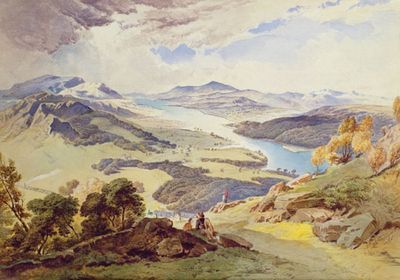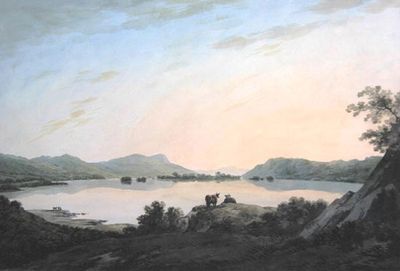The Lakes before Wordsworth

© Bradford Art Galleries and Museums
By MICHAEL CAINES
In October 1769, only a few months before William Wordsworth was born at Cockermouth, on the edge of the Lake District, another poet made a tour of the area: Thomas Gray, more usually associated with Eton College and a certain churchyard in one of the home counties. It's safe to say that he liked what he saw there. The tourist board ought to take him on – posthumously – as a copy-writer.
Despite the references in his journal and letters to "black & dreary plains" and falling over in a "dirty lane" (a common hiker's complaint), Gray could also write happily about the sublime Helvellyn (that "lofty & very rugged mountain"), the road running along the side of Lake Windermere ("with delicious views across it") and the "stupendous" hills near Cockermouth itself.
October 8, he "mounted an eminence called Castle-rigg, & the sun breaking out discover'd the most enchanting view I have yet seen of the whole valley behind me, the two lakes, the river, the mountains all in their glory. had almost a mind to have gone back again". Helm Crag rears into view, "distinguish'd from its rugged neighbours not so much by its height, as by the strange broken outline of its top, like some gigantic building demolish'd, & the stones that composed it, flung cross each other in wild confusion. just beyond it opens one of the sweetest landscapes, that art ever attempted to imitate . . .".
When Gray wasn't walking around the Lake District or the Scottish Highlands – both expeditions being recorded in Bill Roberts's recently revised edition of Thomas Gray's Journals, published by Northern Academic Press – he was usually to be found in Cambridge, reading. So it is not surprising that, although Roberts's volume contains mainly Gray's own prose, his travels occasionally bring his book-learning to mind. There is a perilous pass where the rocks overhead, "hanging loose & nodding forwards", seem to be "just starting from their base in shivers", first putting him in mind of the Alps ("where the Guides tell you to move on with speed, & say nothing, lest the agitation of the air should loosen the snows above"), and then of Dante's vision of the selfish souls trapped before the Gate of Hell, with no hope of death:
Non ragionam di lor; ma guarda, e passa!
(Let us not speak of them; but look, and pass on!)
This might well be an instance of off-the-cuff erudition on Gray's part, show for the old Cambridge friends he was addressing, but it also puts into perspective his explanatory aside about his diligence in recording place names: "Keswick, Crosthwait-church, & Skiddaw . . . Carf-close-reeds". "I chuse to set down these barbarous names, that any body may enquire on the place, & easily find the particular station, that I mean."
The tourist board should ask Gray's spirit if "barbarous" is intended as a put-down or as a kind of compliment – an expression, that is, in eighteenth-century terms, of a civilized city dweller's excitement at tracing survivals of the past in the apparently ancient names for long-lived settlements and the natural wonders that surround them.
Either way, Gray did his job well: Roberts, for one, has been able to follow his path closely and compare Gray's descriptions with how the scenery looks today, from the A66 to the "modern generation" of Ullswater cormorants.
Peter Stothard's Blog
- Peter Stothard's profile
- 30 followers




